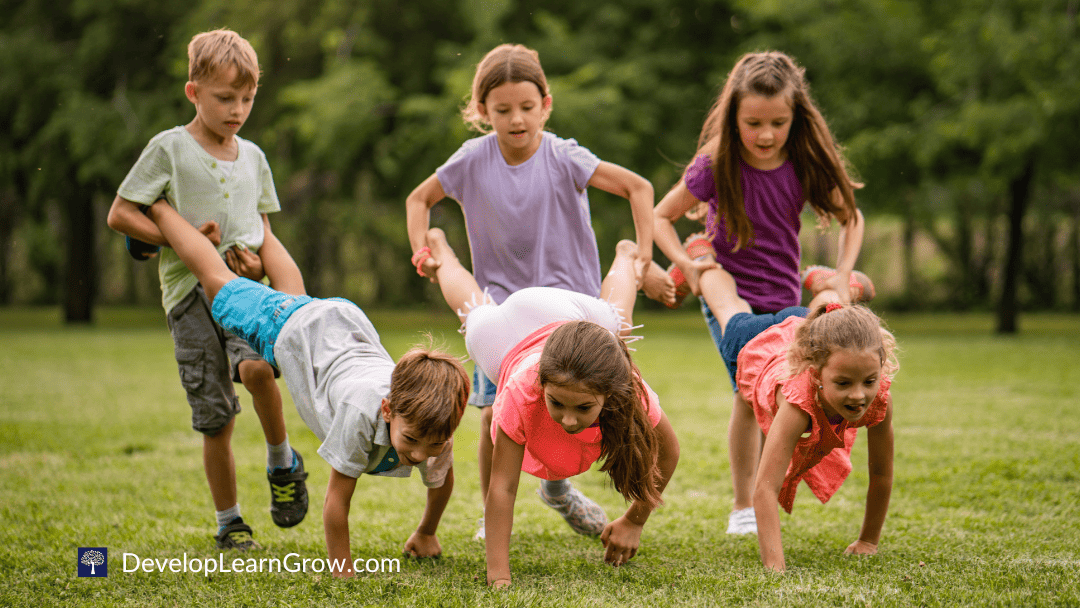Motor coordination activities are great for children’s bodies and brains. Moving more parts of the body activates more parts of the brain. Motor coordination activities are a routine part of my pediatric occupational therapy sessions. They’re great as a warm-up activity or as a therapeutic activity for kids’ bodies and brains.
Not only do I use motor coordination tasks as part of my treatment plan when I’m working one-on-one with individual students but I also use them when I’m working with an entire class of students. All kids need them!
I strongly encourage parents, teachers and students to practice gross motor activities as often as they can. Kids need the movement input as part of their daily routines in order to help improve motor efficiency and independence with daily tasks.
Movement activities are important for sensory processing which supports postural security in kids. Motor coordination activities during my occupational therapy lessons prepares a child’s body and brain. It works on sensorimotor skills such as motor planning, reflex maturity, body awareness, and awareness of two sides of the body.
The coordination activities support perceptual motor development such as eye-hand coordination and eye muscle control and visual perception skills (visual spatial awareness.) Additionally, gross motor coordination activities are an effective way to build motor skills and improve fine motor coordination of the smaller muscles.
What are Gross Motor Skills and Motor Coordination?
Gross motor skills involve using the larger muscles in the body to perform bigger movements. Motor coordination is the ability to move multiple body parts in a coordinated, effective and efficient manner. Motor coordination activities in occupational therapy can consist of gross motor coordination activities, bilateral coordination activities, and fine motor coordination skills activities.
Kids and adults perform gross motor movements either consciously or automatically. For example, conscious movements occur when learning a brand new task such as crawling, climbing, riding a bike, skipping, or learning a new exercise sequence. Practice and mastery of each of the various tasks allows for automatic movements and automatic motor actions (motor planning.)
Motor planning is the ability to plan, organize and carry out a movement or combination of movements. After the body performs the motor task, higher level processing occurs as the muscles send feedback to the brain. If needed, motor adjustments are made in order to master the task or skill. As a result, the skill is mastered and automatic movements occur.
More practice with the task or skill in kids creates automatic movements from the body that are executed in a smooth and coordinated way. For instance, riding a bike requires good balance, strong core muscles, adequate visual processing skills, and good bilateral coordination skills. A child first thinks about and learns each skill step and movement until riding a bike becomes automatic.
Furthermore, practice with motor coordination activities creates and strengthens motor pathways in the brain to allow for automatic movements during everyday actions and routines. Think of all the steps needed to get in a car, place a backpack on the floor, and buckle. Or the steps and skills required while brushing teeth.
Kids learn to conceive, plan and carry out motor tasks correctly from start to finish without stopping to think about it. Then they can complete all the steps without thinking (or even watching) after they master it.

Why are Motor Coordination Activities Important for Kids?
The larger muscles in the body develop before the smaller muscles. Learning to control the big muscles during gross motor activities helps with control during fine motor activities.
Gross motor coordination activities are a great way to give children sensory input for the brain and to build basic life skills. Kids require motor coordination during everyday tasks. Smooth and efficient movements are needed during gross motor activities and for the development of fine motor skills.
Sensory processing skills develop when kids have opportunities to move during everyday activities. Large movements give proprioceptive and vestibular sensory input to the brain that helps with attention and learning.
Large motor movements give proprioceptive input to the large muscle groups and joints in the body. Moving bigger body parts during various activities sends messages to the brain and then the brain sends messages back to the body. This helps with gross motor skill development, muscle tone, and motor planning so that movements become more automatic as kids complete daily activities at home and at school.
Motor coordination activities provide sensory information for the vestibular system through movement and balancing. Young children’s bodies are meant to move!
They need this input in order to develop a foundation for developing other skills, as shown in the Pyramid of Learning Movement helps them perceive where their body is in space. This in turn, helps them develop body awareness and visual perception needed for learning tasks.
Large gross motor movements not only provide sensory input, but they work on coordination of bigger muscles to help make fine motor activities easier. When kids coordinate and control the large muscles of the body well, it helps with being able to control the smaller muscles in the body.
Examples of Motor Coordination Activities for Kids in OT and During Everyday Activities
There are a few different types of motor coordination movements depending on the motor activity.
Gross motor coordination activities involve learning and performing different movements throughout the body. Basically, coordination tasks can involve symmetrical movements in the body where both sides of the body are doing the same thing. For example, symmetrical movements are used when clapping, jumping with two feet onto a target or doing jumping jacks.
Additionally, motor coordination tasks can involve reciprocal movements such as when crawling, climbing, running, walking up steps, or ice skating. Gross motor and fine motor coordination tasks can also include bilateral movements where each side of the body is doing something different (hopping on one foot, playing the drums, or holding paper with the non-dominant hand while cutting with scissors.)
Motor coordination activities involve bilateral integration, visual motor integration, and fine motor skills that are needed for daily tasks. These coordination activities improve a child’s abilities to be more independent during self-help and fine motor activities.
For example, learning to crawl or climb steps helps develop bilateral movements that are later needed during a fine motor task such as putting on clothing, engaging a zipper, snipping paper, or tying laces of a shoe.
Another example is using the entire arm to “sky writing” letters in the air using the index finger. This helps the body and brain feel, understand and learn movements that are needed when learning to form letters properly. Kids are able to better understand moving small muscles from top down or around in a controlled manner after using the big muscles.

Gross Motor Coordination Activities for Kids in Occupational Therapy
Young children need daily opportunities for full body motor coordination activities.
The following list of gross motor coordination activities are ones that I use as a pediatric occupational therapist. They are a routine part of my treatment plan. The coordination activities are separated into two categories.
Firstly, I’m sharing basic gross motor coordination activities for preschoolers and kindergarten students.
Then, I list higher level coordination activities for older elementary students.
My favorites activities are the ones that work on core strength, balance, and arm strength, as well as tasks that give proprioceptive input and work on motor planning.
Motor Coordination Activities for Preschool and Kindergarten Students
- Walking on a line taped on the floor – (straight line, or lines with changes in direction; wide then thin)
- Balance beam
- Walking on steppingstones – (motor planning, core work, body control, and balance)
- Short obstacle courses
- Jumping with 2 feet together – (great way to give proprioceptive input)
- Jumping with 2 feet together onto targets – (use tape on the floor, rubber floor spotters, tiles, or designs on the floor or carpet)
- Crab walk – Fun ways to work on core muscles, reciprocal movements of the arms AND legs, and shoulder stability and hand strength. Crab walks are a kid favorite!
- Balancing on each foot
- Stepping over objects
- Jumping over a low object
- Galloping
- Skipping
- Hopping on 1 foot – (great amounts of proprioceptive input)
- Hopping on 1 foot on a target
- Marching – (vary the speed and direction)
- Cross crawls – (a slow march where opposite elbow touches opposite knee)
- Riding a bike
- Wheelbarrow walking
- Hoppity ball – (great core, deep pressure, body control, and movement activity)
- Arm circles or airplane flying
- Motor imitation songs – (wonderful coordination activities that are also great for sequencing and following directions. See 20 Movement Songs from Growing Little Brains)
- Boom whackers or rhythm sticks – (adding auditory input and rhythm are great for the brain for learning!)
Motor Coordination Activities for Elementary Students
- Jumping jacks
- Catching a ball
- Bouncing and catching a tennis ball
- Velcro catch mitt
- Throwing a ball or beanbag to target
- Bowling games
- Kicking to a target
- Modified hockey or paddle ball
- Reciprocal stride jumps
- Inchworm
- Imitating movement patterns
- Pattern clapping
- Rhythm tapping
- Limbo
- Jumping side to side over a line
- Hopscotch
- Jumping rope
- Hula hoop
- Pogo stick
- Walking stilts
- Roller racer
Have fun with these motor coordination activities. They significantly make a difference with the kids that I see during my work as an occupational therapist. I’m sure you will see a difference when your young children can practice them too!
Additional Resources and Occupational Therapy Ideas for Motor Coordination Activities for Kids
- 61 Fun Indoor Gross Motor Activities for Kids
- Skill Building Outdoor Games for Kids
- 40 Core Exercises for Kids (free printable)
- 25 Proprioceptive Brain Breaks to Improve Focus and Attention (free printable)
- 30 Easy Movement Activities for Kids
Interested in an 8-Week Brain Break Exercise Program?
Whenever I work with large classrooms in schools, I share whole class exercises to build important motor skills for kids. I’ve had great feedback on this 8-week classroom exercise program. It includes core exercises, crossing midline, sensory activities for learning, visual activities, hand dexterity, and more!
It shares a series of exercises to practice every day for 8 weeks.
Use these specific occupational therapy exercises to improve:
Attention… focus… core stability… crossing midline… sensory processing… visual development… & more… Click for more info!




0 Comments